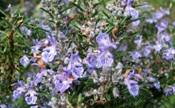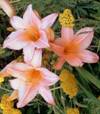They Look Pretty, They Taste Good, They Add Nutrition

After falling out of favor for many years, cooking and garnishing with flowers is back in vogue once again—this nearly lost art is enjoying a revival. Flower cookery has been traced back to Roman times, and to the Chinese, Middle Eastern, and Indian cultures. Edible flowers were especially popular in the Victorian era during Queen Victoria's reign.
Today, many restaurant chefs and innovative home cooks garnish their entrees with flower blossoms for a touch of elegance. The secret to success when using edible flowers is to keep the dish simple, do not add too many other flavors that will overpower the delicate taste of the flower. Most herb flowers have a taste that's similar to the leaf, but spicier. Iron, Calcium, phosphorus and vitamins A and C are the added benefits to including them in recipes.
Fun facts to know and tell: Did you know that broccoli, cauliflower, and artichokes are all flowers? Also the spice saffron is the stamen from the crocus flower? Capers are unopened flower buds to a bush native in the Mediterranean and Asian nations.
Important to remember—not every flower is edible. In fact, sampling some flowers can make you very, very sick. Also, NEVER use pesticides or other chemicals on any part of any plant that produces blossoms you plan to eat. Identify the flower exactly and eat only edible flowers, and edible parts of those flowers.
Some dos and don’ts:
 DO
DO use flowers sparingly in recipes and introduce them into your diet in small quantities, one species at a time, due to digestive complications that can occur with a large consumption rate.
DO wash all flowers thoroughly before eating.
DO remove pistils and stamens from flowers before eating. Separate the flower petals from the rest of the flower just prior to use to keep wilting to a minimum. Eat only the flower petals for most flowers.
DO NOT eat flowers from florists, nurseries or garden centers. In many cases these flowers have been treated with pesticides not labeled for food crops.
DO NOT eat flowers picked from the side of the road. Once again, possible herbicide use eliminates these flowers as a possibility for use. Remove pistils and stamens from flowers before eating. Eat only the flower petals for most flowers.
Now a few edible flower recipes:
DAYLILY PETAL SALAD

6 C lettuce, washed, spun dry and torn into bite-sized pieces
2 Tbsp cold-pressed olive oil
2 tsp fresh, lemon juice
Salt and freshly ground pepper to taste
¼ C purple basil leaves
Petals from four to eight blossoms
Place lettuce in serving bowl. Drizzle oil evenly over lettuce. Toss well. Drizzle lemon juice over lettuce and sprinkle with salt. Toss again. Add basil, but toss with only top layer of the lettuce, so the beautiful purple leaves show through the greens. Grind pepper over the top. Garnish with daylily petals--placed randomly, or in a circle around the outside, or decoratively in center of the bowl.
 Download this recipe.
LAVENDER TEA COOKIES
Download this recipe.
LAVENDER TEA COOKIES

1 Tbsp dried culinary lavender flowers
1 C butter, room temperature
2/3 C sugar
1 tsp pure vanilla extract
¼ tsp lemon extract
2 C all-purpose flour
1/8 teaspoon salt
Lavender Frosting (see recipe below)
In a mortar, grind lavender flowers with the pestle. In medium bowl, cream together ground lavender flowers, butter, sugar, vanilla extract, and lemon extract. Add flour and salt; mix until combined (dough should be soft but not sticky.) Refrigerate 1- 2 hours or until dough is firm.
Preheat oven to 325°. Remove dough from refrigerator. On lightly floured surface, roll dough approximately ¼” thick. Cut with cookie cutters and place onto ungreased cookie sheets. Bake 12- 15 minutes or until cookies are lightly browned around the edges. Remove from oven and cool. When cool, frost with Lavender Frosting. Makes 2 dozen cookies.
Lavender Frosting:

1 C powdered sugar
2 Tbsp dried culinary lavender flowers
2 Tbsp milk
2 tsp melted butter
In a small plastic bag, combine powdered sugar and dried lavender flowers. Let stand at least 1 day before using. When ready to use, sift the mixture into a medium-size bowl; discarding whatever lavender doesn’t fall through.
Add milk and melted butter, mixing well.
NOTE: Additional powdered sugar or milk may need to be added (enough milk to make frosting easy to spread). Spread on cooled cookies.
 Download this recipe.
Download this recipe.
 Pansy
Pansy - Pansies have a slightly sweet green or grassy flavor. If you eat only the petals, the flavor is extremely mild, but if you eat the whole flower, there is a winter, green overtone. Use them as garnishes, in fruit salads, green salad, desserts or in soups.
 Nasturtium
Nasturtium - Comes in varieties ranging from trailing to upright and in brilliant sunset colors with peppery flavors. Nasturtiums rank among most common edible flowers. The blossoms have a sweet, spicy flavor, similar to watercress. Stuff whole flowers with savory mousse. Leaves add peppery tang to salads. Pickled seed pods are less expensive substitute for capers. Use entire flowers to garnish platters, salads, cheese tortas, open-faced sandwiches, and savory appetizers.
Contribute to the Cook'n Club!
DVO would love to publish your article, prose, photography and art as well as your cooking, kitchen and nutrition tips, tricks and secrets. Visit the Newsletter Submission / Win Win for All section in our Forum for more information and details.



